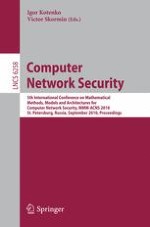This volume contains papers presented at the 5th International Conference on Mat- matical Methods, Models and Architectures for Computer Network Security (MMM-ACNS 2010) held in St. Petersburg, Russia, during September 8-10, 2010. The conference was organized by the Institution of the Russian Academy of Sciences St. Petersburg Institute for Informatics and Automation of RAS (SPIIRAS) in co- eration with Binghamton University (SUNY). The previous conferences in the series (MMM-ACNS 2001, MMM-ACNS 2003, MMM-ACNS 2005 and MMM-ACNS 2007) organized by SPIIRAS and Binghamton University (SUNY) demonstrated the great interest of the international scientific community in the theoretical and practical aspects of computer network and information security. MMM-ACNS 2010 provided the next international forum for sharing original - search results among specialists in fundamental and applied problems of computer network security. A total of 54 papers from 19 countries related to significant aspects of the theory and applications of computer network and information security were submitted to MMM-ACNS 2010: 16 papers were selected for regular and 6 for short presentations (30% of acceptance for full papers and 40% for all papers).
